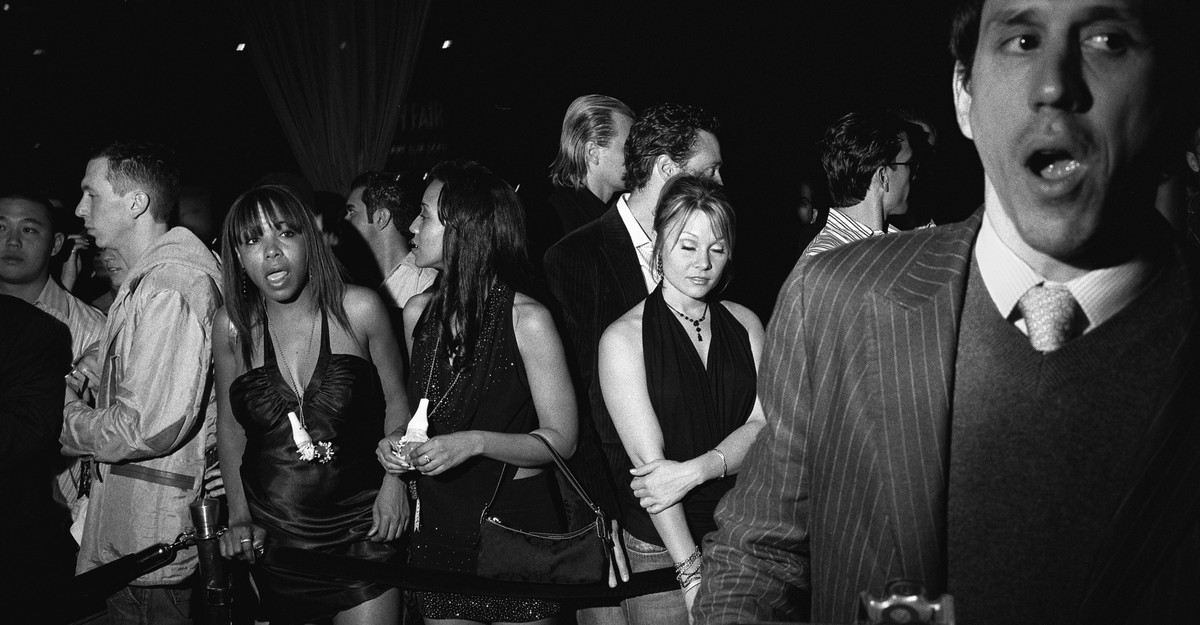
In the past two years, Reuben A. Buford May, a sociology professor at the University of Illinois at Urbana-Champaign, has spent a lot of time waiting in lines at Chicago nightclubs. When he gets to the front, he never knows how much, exactly, the bouncer is going to tell him to pay to enter. May, who previously wrote a book about urban nightlife and is researching another, has seen bouncers let in a series of white patrons for free, then charge a group of Black patrons, then allow the next group of white people to get in for free again. “I have literally been in line and was the next person to enter the nightclub and suddenly the price goes up,” May, who is Black, told me. “Is this about race or about profit?”
The unfortunate answer is probably both. Cover charges, which in May’s experience usually hover from $10 to $20 and are generally paid to a bouncer, occupy a strange space in the U.S.: In many places, they can be flagrantly discriminatory, yet legally permitted. They might shift based on the time of night as well as the demeanor, outfit, and physical characteristics of the person in line. Although racial discrimination certainly happens in nightlife—“It’s clear to me that the race of the patron influences what the bouncer charges,” May said—proving that a specific cover charge is discriminatory because of prejudice against a protected class is also complicated. At a club, most people already understand that they will be judged for their appearance.
In the larger economy, there’s pretty much nothing else like cover charges. Airlines and Airbnbs use variable pricing models, where the cost of a seat or a stay fluctuates with demand. Time-based promotions are common too: If you arrive at IHOP at 3 p.m., you can score a discount on pancakes. But these deals are, in theory, unbiased—anyone can be entitled to a discount. What makes nightlife unique is how personal, arbitrary, and sometimes humiliating these charges may be. You are intimately scrutinized, and then you have to pay according to how desirable your presence is to the venue.
Cover charges, along with dress codes, are essentially the levers by which nightlife venues curate people—or outright reject them. This price discrimination is perhaps tolerated only because the promise of a highly selective experience is why many people show up in the first place.
Since their inception in New York at the start of the 20th century, cover charges have offered a dual benefit to nightclub owners: a way to maximize profits while also screening out the patrons they don’t want. In October 1926, for example, a columnist for The New Yorker complained that “the five-dollar couvert, with no frills, is to be an ordinary occurrence” across the city. Venue owners seemed to be using cover charges as a way to keep out nonwealthy clientele. They were not subtle about it either. In 1936, Fortune magazine described how the famed Manhattan nightclub El Morocco used an “elastic cover charge” to “separate the chic from the goats.” To cultivate an air of exclusivity, El Morocco charged different covers to different patrons based on “how much you spend, how regularly you come, who you are, and whether they wanna discourage you coming back altogether,” according to a contemporaneous report in Variety.
As crude as the cover-charge policy of El Morocco might sound, it is not out of step with how the fees function today: What you pay often boils down to how desirable of an addition you are to the venue. “It’s just based on your look or your vibe,” Jason Beahm, a defense lawyer who, among other specialties, focuses on festivals and nightlife, told me. Many club operators are not shy about the fact that they are filtering customers. When the New York Post interviewed bouncers who work at high-end venues, they described their ideal patrons as a “mature, martini-drinking crowd,” as well as those with “distinctive looks,” “high fashion,” and the ability to make a space “more sexy, more elegant, more fun.” To discourage people in their early 20s, whom it associated with disorder, from entering, one Harrisburg, Pennsylvania, bar has even charged young people extra. Many a service-journalism article has been devoted to getting into Berghain, Berlin’s most exclusive nightclub.
A close curation of patrons can, and often does, lead to discrimination against people of color, disabled people, and queer people. One of the few ways that variable cover charges can become illegal is when they involve a provable pattern of targeting people belonging to protected classes. In 2016, for instance, the Department of Justice filed a lawsuit against the Houston club Gaslamp for repeatedly charging a $20 cover to people of color while allowing white people to enter for free. (The suit was eventually settled.) The problem with proving discrimination at clubs is that dress codes can easily be used as an alibi for it. In a 2021 paper, the legal scholar Shaun Ossei-Owusu called cover charges and dress codes part of a regime of “velvet rope discrimination,” referring to a series of norms that exclude women, queer people, and racial minorities from certain nightlife venues.
For example, dress-code policies have resulted in nightclubs turning away Black people for having dreadlocks, and refusing queer and trans people for wearing makeup. When one Texas man was barred from a club for wearing makeup and false eyelashes, employees told him that “men need to dress like men,” Ossei-Owusu recounted in his paper. This spring, a gay club in Washington, D.C., was criticized for banning high heels, a policy that seemed designed to exclude women, trans people, and drag queens. (The club has since dropped the policy.)
Yet besides defending protected classes, meaningful policies governing cover charges and dress codes are largely absent from the legal landscape. If you see cover-charge laws bubble up in the news, it is probably for one reason: Men’s-rights activists have spent years suing states over establishments that charge women less than men to enter, a common promotion designed to make a nightclub more desirable … to men. In California, Pennsylvania, Maryland, and Wisconsin, differential charges based on gender are illegal; in states such as Washington and Illinois, by contrast, courts found no issue with them. These promotions aside, states have very little to say on how cover charges are levied, or how much they can be.
One of the rare exceptions is Massachusetts, which requires any business that receives a liquor license to ensure that a sign with letters of at least one inch in height is “conspicuously posted,” at every entrance, noting how much the cover is if one is required. Violating the law is punishable by a small fine of up to $50. The Massachusetts state Senate passed the regulation in 1951—not to prevent discrimination but, apparently, to protect the dignity of men wooing their girlfriends. A sign out front was needed, one state senator said, because “if a man goes into a place, and then finds a big cover or minimum charge, it’s too embarrassing to get up and leave, if he’s with a girl friend.”
In the intervening decades, few other states or municipalities followed that state’s lead. Perhaps one reason is that these tools of exclusion in nightlife, as profoundly as they can be used to harm, can also have some upsides for patrons. Cover charges and dress codes have even been used to keep nightclubs safe for communities who are discriminated against in other contexts. At one London party for queer people of color, for instance, bouncers ask anyone who doesn’t visibly seem to belong to these communities “how they identify and why they were coming,” an organizer explained to Dazed. At some parties, you have to apply to attend.
Curation is a central component of nightlife. Nightclubs are facilitators of a shared, communal experience; shaping that community requires a degree of exclusion. You go to a death-metal night, and you expect the metalheads to turn out. You go to a queer club, and you expect a mix of sexualities and genders. “Nightclubs in and of themselves are places of exclusion,” May, the University of Illinois professor, said. “They are focused on selecting people out that deserve the right to be a part of that entertainment.”
This tension sits unresolved: The certainty that you’ll share a connection with the crowd is part of the reason that good nightclubs feel so thrilling, but those same curation mechanisms keep people out unfairly. Still, to hold nightclubs accountable for prejudice, visible cover charges would be a vital start. If a sign announces the price, a club will at least have to own its decision to bar someone from entry, rather than hide behind a made-up fee.




